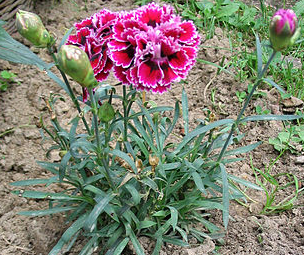
Shakespeare’s carnation, also called gillyflower and clove pink, was probably the herbaceous perennial Dianthus caryophyllus. The genus Dianthus is in the family Caryophyllaceae and has over 300 species including pinks and sweet William. The sweetly scented flowers of D. caryophyllus are borne singly or in groups of up to five in summer. Each flower has five petals with “pinked” or fringed edges and is one to two inches across. The original species was purplish pink but modern day hybrids are all shade of pink, red, white, and even yellow and green. The leaves are gray-green to blue-green, linear, and up to six inches long. Plants grow up to thirty inches tall and need full sun, and very well-drained, neutral to slightly alkaline soil. They are hardy in USDA zones 4-9
In Winter’s Tale (act iv, sc 4, 81) the princess, Perdita. living as a shepherdess, greets Polyxenes, the disguised father of the man to whom she is about to be betrothed, as she plays hostess at a sheep-shearing;
the fairest
flowers o’ the season
Are our carnations and streak’d gillyvors,
Which some call nature’s bastards:
Later in the same scene (act vi, sc 4, 98), Polyxenes, tells Perdita;
Then make your garden rich in gillyvors,
And do not call them bastards.
Carnations have been known since ancient Greek and Roman times when they were used to make garlands (coronae) and ceremonial crowns. Christain legends associates the first appearance of carnations with the tears Mary shed when she saw Jesus carrying the cross. At some time the flower took on the meaning of admiration, fascination, ardent and pure love, unfading beauty, and woman’s love but these meanings may not have been known in Shakespeare’s time.
The generic name Dianthus comes from the Greek dios meaning god, and anthos meaning flower. Some people believe that the common name carnation comes from coronation referring the ancient use of the flowers. The sixteenth century herbalist, Gerard, derives the name carnation from the color of its flowers (Latin carnatio meaning fleshlikenness). The common name gillyflower comes from the Greek karyo (nut) and phyllon (leaf), together meaning clove.